brake KIA K900 2017 Features and Functions Guide
[x] Cancel search | Manufacturer: KIA, Model Year: 2017, Model line: K900, Model: KIA K900 2017Pages: 62, PDF Size: 6.38 MB
Page 3 of 62
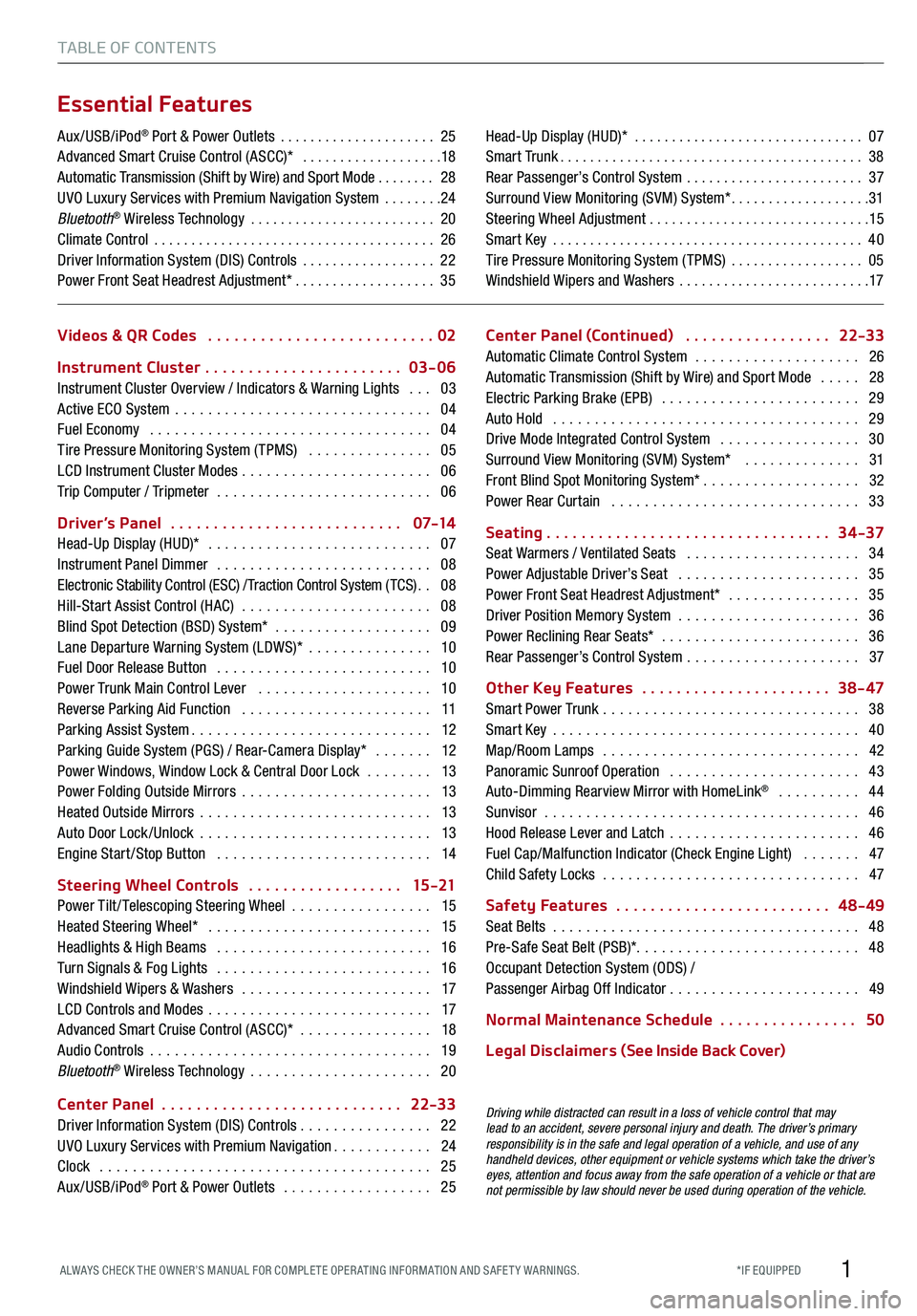
1
TABLE OF CONTENTS
Videos & QR Codes ..........................02
Instrument Cluster
.......................03-06
Instrument Cluster Overview / Indicators & Warning Lights ...03
Active ECO System ...............................04
Fuel Economy ..................................04
Tire Pressure Monitoring System (TPMS) ...............05
LCD Instrument Cluster Modes .......................06
Trip Computer / Tripmeter ..........................06
Driver’s Panel
...........................0 7-14
Head-Up Display (HUD)* ...........................07
Instrument Panel Dimmer ..........................08
Electronic Stability Control (ESC) / Traction Control System ( TCS) ..08
Hill-Start Assist Control (HAC) .......................08
Blind Spot Detection (BSD) System* ...................09
Lane Departure Warning System (LDWS)* ...............10
Fuel Door Release Button ..........................10
Power Trunk Main Control Lever .....................10
Reverse Parking Aid Function .......................11
Parking Assist System .............................12
Parking Guide System (PGS) / Rear-Camera Display* .......12
Power Windows, Window Lock & Central Door Lock ........13
Power Folding Outside Mirrors .......................13
Heated Outside Mirrors ............................13
Auto Door Lock /Unlock ............................13
Engine Start /Stop Button ..........................14
Steering Wheel Controls
..................15 -21
Power Tilt/ Telescoping Steering Wheel .................15
Heated Steering Wheel* ...........................15
Headlights & High Beams ..........................16
Turn Signals & Fog Lights ..........................16
Windshield Wipers & Washers .......................17
LCD Controls and Modes ...........................17
Advanced Smart Cruise Control (ASCC)* ................18
Audio Controls ..................................19
Bluetooth® Wireless Technology ......................20
Center Panel
............................22-33
Driver Information System (DIS) Controls ................ 22
UVO Luxury Services with Premium Navigation
............24
Clock ........................................25
Aux/USB/iPod® Port & Power Outlets ..................25 Center Panel (Continued)
.................22-33
Automatic Climate Control System ....................26
Automatic Transmission (Shift by Wire) and Sport Mode .....28
Electric Parking Brake (EPB) ........................29
Auto Hold .....................................29
Drive Mode Integrated Control System .................30
Surround View Monitoring (SVM) System* ..............31
Front Blind Spot Monitoring System* ...................32
Power Rear Curtain ..............................33
Seating
.................................34-37
Seat Warmers / Ventilated Seats .....................34
Power Adjustable Driver’s Seat ......................35
Power Front Seat Headrest Adjustment* ................35
Driver Position Memory System ......................36
Power Reclining Rear Seats* ........................ 36
Rear Passenger’s Control System ..................... 37
Other Key Features
......................38 - 47
Smart Power Trunk ...............................38
Smart Key .....................................40
Map/Room Lamps ...............................42
Panoramic Sunroof Operation .......................43
Auto-Dimming Rearview Mirror with HomeLink® .......... 44
Sunvisor ......................................46
Hood Release Lever and Latch .......................46
Fuel Cap/Malfunction Indicator (Check Engine Light) .......47
Child Safety Locks ...............................47
Safety Features
.........................48-49
Seat Belts .....................................48
Pre-Safe Seat Belt (PSB)* ........................... 48
Occupant Detection System (ODS) /
Passenger Airbag Off Indicator
....................... 49
Normal Maintenance Schedule
................50
L ega l D i sc la ime r s (See Inside Back Cover)
Driving while distracted can result in a loss of vehicle control that may
lead to an accident, severe personal injury and death. The driver’s primary
responsibility is in the safe and legal operation of a vehicle, and use of any
handheld devices, other equipment or vehicle systems which take the driver’s
eyes, attention and focus away from the safe operation of a vehicle or that are
not permissible by law should never be used during operation of the vehicle.
Aux/USB/iPod® Port & Power Outlets .....................25
Advanced Smart Cruise Control (ASCC)* ...................18
Automatic Transmission (Shift by Wire) and Sport Mode ........ 28
UVO Luxury Services with Premium Navigation System ........24
Bluetooth® Wireless Technology .........................20
Climate Control ......................................26
Driver Information System (DIS) Controls ..................22
Power Front Seat Headrest Adjustment* ...................35 Head-Up Display (HUD)*
...............................07
Smart Trunk .........................................38
Rear Passenger’s Control System ........................37
Surround View Monitoring (SVM) System* ...................31
Steering Wheel Adjustment ..............................15
Smart Key ..........................................40
Tire Pressure Monitoring System (TPMS) ..................05
Windshield Wipers and Washers ..........................17
Essential Features
*IF EQUIPPED
ALWAYS CHECK THE OWNER’S MANUAL FOR COMPLE TE OPER ATING INFORMATION AND SAFE T Y WARNINGS.
Page 5 of 62
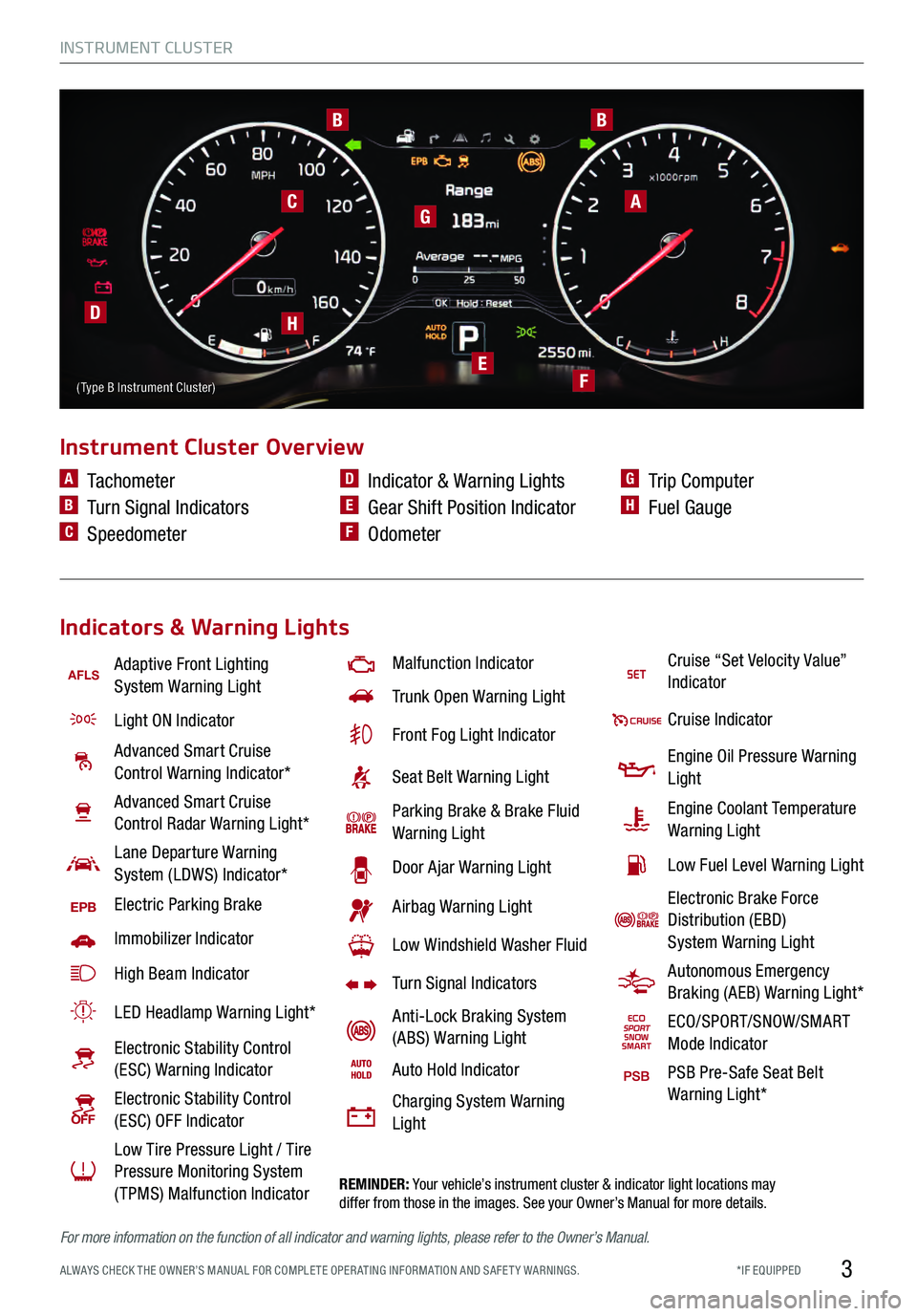
3
www.KuTechVideos.com/kh13/2017
AFLSAdaptive Front Lighting System Warning Light
Light ON Indicator
Advanced Smart Cruise Control Warning Indicator*
Advanced Smart Cruise
Control Radar Warning Light*
Lane Departure Warning
System (LDWS) Indicator*
EPBElectric Parking Brake
Immobilizer Indicator
High Beam Indicator
LED Headlamp Warning Light*
Electronic Stability Control (ESC) Warning Indicator
Electronic Stability Control (ESC) OFF Indicator
Low Tire Pressure Light / Tire
Pressure Monitoring System
(TPMS) Malfunction Indicator
Malfunction Indicator
Trunk Open Warning Light
Front Fog Light Indicator
Seat Belt Warning Light
Parking Brake & Brake Fluid Warning Light
Door Ajar Warning Light
Airbag Warning Light
Low Windshield Washer Fluid
Turn Signal Indicators
Anti-Lock Braking System
(ABS) Warning Light
Auto Hold Indicator
Charging System Warning
Light
REMINDER: Your vehicle’s instrument cluster & indicator light locations may
differ from those in the images. See your Owner’s Manual for more details.
Instrument Cluster Overview
Indicators & Warning Lights
A Tachometer
B Turn Signal Indicators
C Speedometer
D Indicator & Warning Lights
E Gear Shift Position Indicator
F Odometer
G Trip Computer
H Fuel Gauge
A
BB
C
D
E
H
G
F
Cruise “Set Velocity Value” Indicator
Cruise Indicator
Engine Oil Pressure Warning Light
Engine Coolant Temperature Warning Light
Low Fuel Level Warning Light
Electronic Brake Force Distribution (EBD)
System Warning Light
Autonomous Emergency Braking (AEB) Warning Light*
ECO/SPORT/SNOW/SMART Mode Indicator
PSB Pre-Safe Seat Belt Warning Light*
( Type B Instrument Cluster)
For more information on the function of all indicator and warning lights, please refer to the Owner’s Manual.
INSTRUMENT CLUSTER
*IF EQUIPPED
ALWAYS CHECK THE OWNER’S MANUAL FOR COMPLE TE OPER ATING INFORMATION AND SAFE T Y WARNINGS.
Page 10 of 62
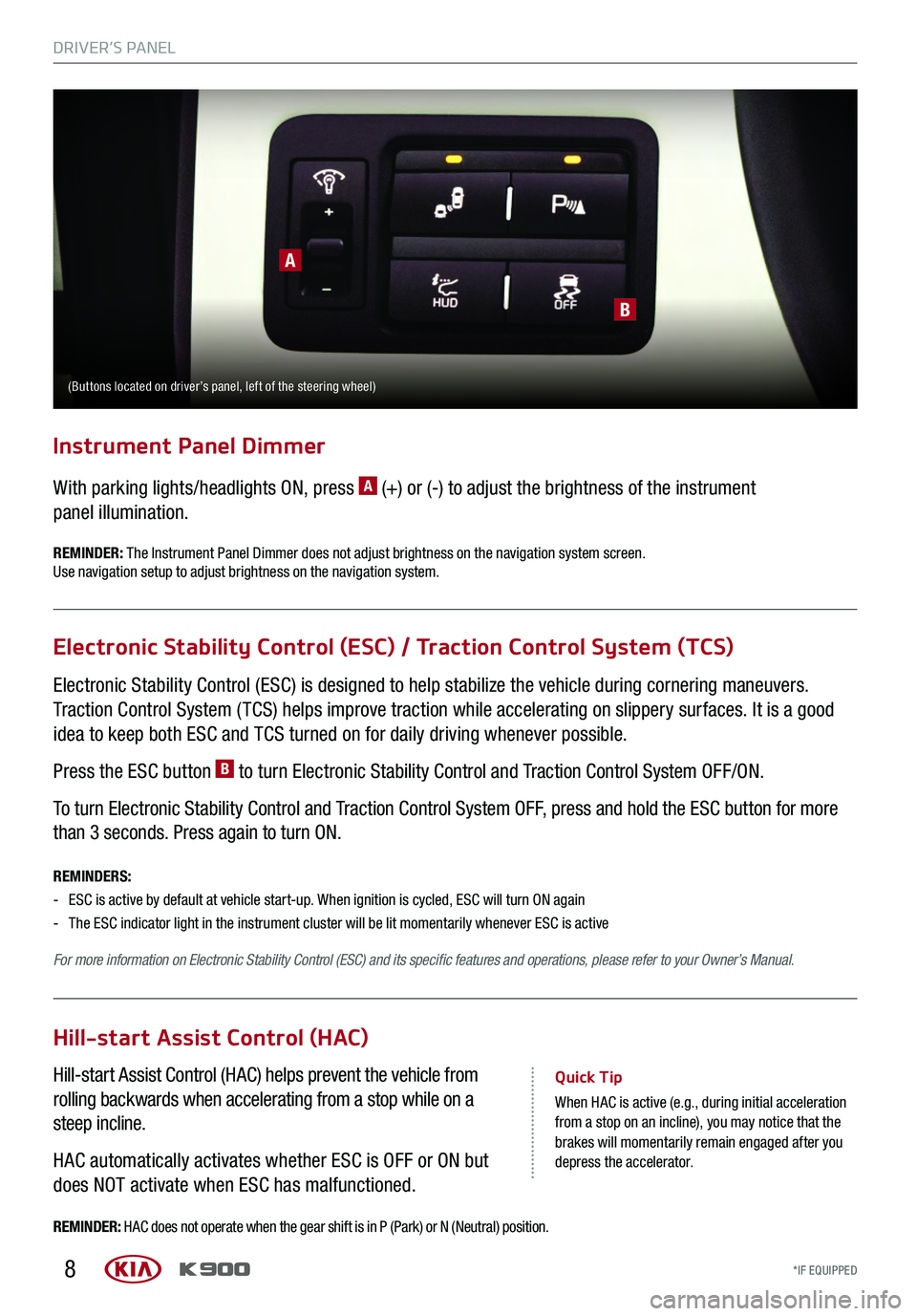
8
Electronic Stability Control (ESC) is designed to help stabilize the vehicle during cornering maneuvers.
Traction Control System ( TCS) helps improve traction while accelerating on slippery surfaces. It is a good
idea to keep both ESC and TCS turned on for daily driving whenever possible.
Press the ESC button
B to turn Electronic Stability Control and Traction Control System OFF/ON.
To turn Electronic Stability Control and Traction Control System OFF, press and hold the ESC button for more
than 3 seconds. Press again to turn ON.
Electronic Stability Control (ESC) / Traction Control System (TCS)
REMINDERS:
- ESC is active by default at vehicle start-up. When ignition is cycled, ESC will turn ON again
- The ESC indicator light in the instrument cluster will be lit momentarily whenever ESC is active
For more information on Electronic Stability Control (ESC) and its specific features and operations, please refer to your Owner’s Manual.
Hill-start Assist Control (HAC)
Hill-start Assist Control (HAC) helps prevent the vehicle from
rolling backwards when accelerating from a stop while on a
steep incline.
HAC automatically activates whether ESC is OFF or ON but
does NOT activate when ESC has malfunctioned.Quick Tip
When HAC is active (e.g., during initial acceleration from a stop on an incline), you may notice that the
brakes will momentarily remain engaged after you
depress the accelerator.
REMINDER: HAC does not operate when the gear shift is in P (Park) or N (Neutral) position.
With parking lights/headlights ON, press A (+) or (-) to adjust the brightness of the instrument
panel illumination.
Instrument Panel Dimmer
REMINDER: The Instrument Panel Dimmer does not adjust brightness on the navigation system screen.
Use navigation setup to adjust brightness on the navigation system.
A
B
(Buttons located on driver’s panel, left of the steering wheel)
DRIVER’S PANEL
*IF EQUIPPED
DRIVER’S PANEL
*IF EQUIPPED
Page 16 of 62

14
To start the engine:
1. Depress the brake pedal
2. Press the ENGINE START/STOP button while gear shift is
in P (Park)
To turn the engine OFF, press the ENGINE START/STOP
button while the gear shift is in P (Park).
To use the ENGINE START/STOP button, you must have the
Smart Key on your person or inside the vehicle.
Engine Start/Stop Button
www.KuTechVideos.com/kh13/2017
ENGINE STA RT/STOP
BUTTON AND
SMART KEY VIDEO
To view a video on
your mobile device,
snap this QR Code or
visit the listed website.
Refer to page 2 for
more information.
REMINDERS:
- If Smart Key fob battery is dead, you can still start the engine by pressing
the ENGINE START/STOP button with the Lock-button end of the Smart
Key. The Smart Key must contact the ENGINE START/STOP button directly,
at a right angle
- In an emergency situation while the vehicle is in motion, you are able to turn
the engine off and to the ACC position by pressing the ENGINE START/ STOP
button for more than 2 seconds or 3 times successively within 3 seconds
B
CA
Quick Tips
To use electrical accessories:
ACC position
- When in the OFF position A and without
depressing the brake pedal, press the ENGINE
START/STOP
button once. The ACC indicator will illuminate (amber) B.
To check warning light s:
ON position
- When already in the ACC position B and without
depressing the brake pedal, press the ENGINE
START/STOP button again. The ON indicator will
illuminate (red)
C.
- When in the OFF position A and without
depressing the brake pedal, press the ENGINE
START/STOP button twice. The ON indicator will
illuminate (red)
C.
Keeping the vehicle in ACC or ON position too long
can discharge the vehicle’s battery .
DRIVER’S PANEL
*IF EQUIPPED
DRIVER’S PANEL
*IF EQUIPPED
Page 18 of 62
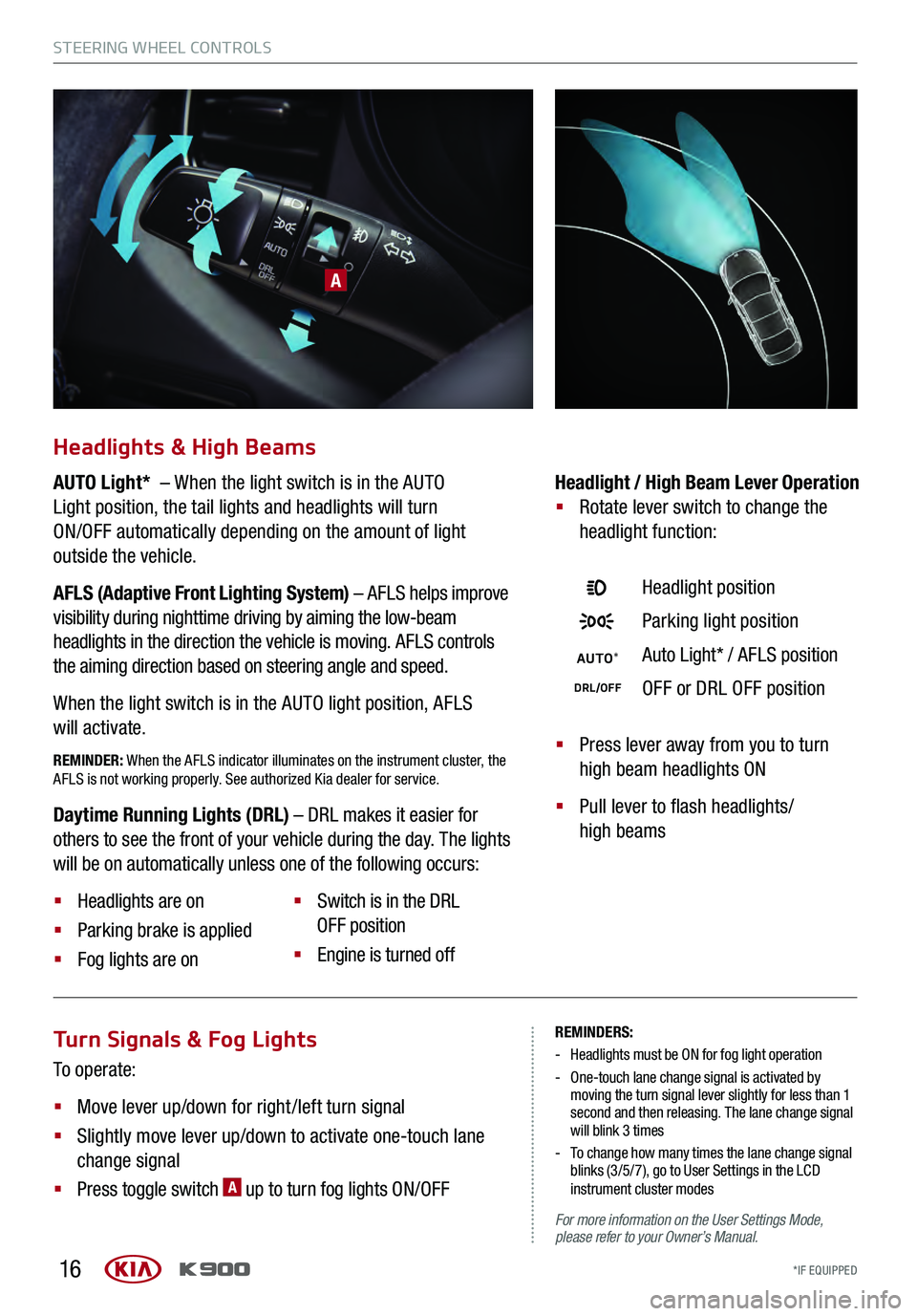
16
Turn Signals & Fog Lights
To operate:
§
Move lever up/down for right /left turn signal
§
Slightly move lever up/down to activate one-touch lane
change signal
§
Press toggle switch A up to turn fog lights ON/OFF
REMINDERS:
- Headlights must be ON for fog light operation
- One-touch lane change signal is activated by
moving the turn signal lever slightly for less than 1
second and then releasing. The lane change signal
will blink 3 times
- To change how many times the lane change signal blinks (3/5/7), go to User Settings in the LCD
instrument cluster modes
For more information on the User Settings Mode,
please refer to your Owner’s Manual.
A
Headlights & High Beams
AUTO Light* – When the light switch is in the AUTO
Light position, the tail lights and headlights will turn
ON/OFF automatically depending on the amount of light
outside the vehicle.
AFLS (Adaptive Front Lighting System) – AFLS helps improve
visibility during nighttime driving by aiming the low-beam
headlights in the direction the vehicle is moving. AFLS controls
the aiming direction based on steering angle and speed.
When the light switch is in the AUTO light position, AFLS
will activate.
REMINDER: When the AFLS indicator illuminates on the instrument cluster, the
AFLS is not working properly. See authorized Kia dealer for service.§ Press lever away from you to turn
high beam headlights ON
§
Pull lever to flash headlights/
high beams
Headlight / High Beam Lever Operation
§
Rotate lever switch to change the
headlight function:
Headlight position
Parking light position
AUTO *Auto Light* / AFLS position
DRL/OFFOFF or DRL OFF position
Daytime Running Lights (DRL) – DRL makes it easier for
others to see the front of your vehicle during the day. The lights
will be on automatically unless one of the following occurs:
§ Headlights are on
§ Parking brake is applied
§ Fog lights are on §
Switch is in the DRL
OFF position
§ Engine is turned off
STEERING WHEEL CONTROLS
*IF EQUIPPED
STEERING WHEEL CONTROLS
*IF EQUIPPED
Page 20 of 62
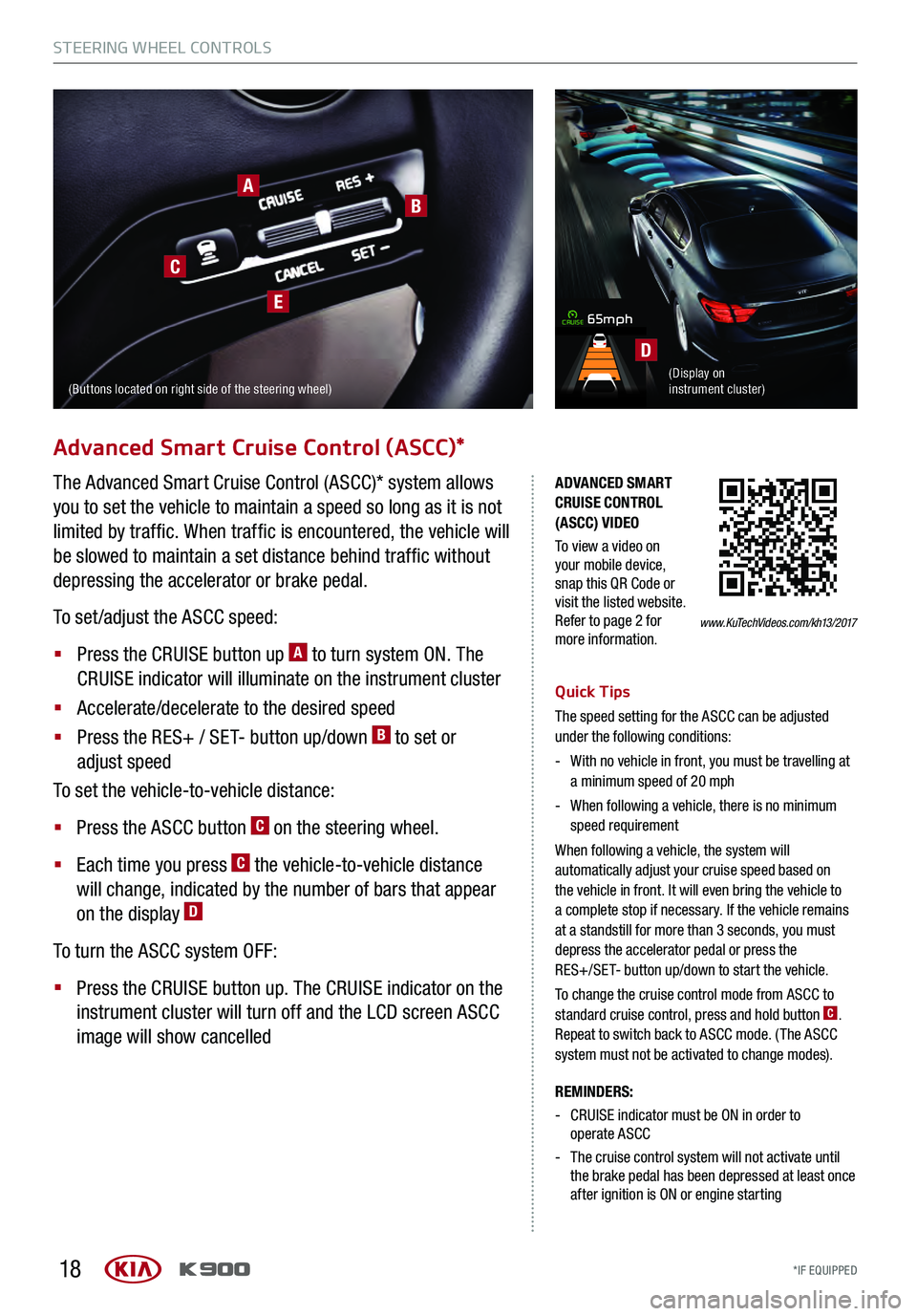
18
The Advanced Smart Cruise Control (ASCC)* system allows
you to set the vehicle to maintain a speed so long as it is not
limited by traffic. When traffic is encountered, the vehicle will
be slowed to maintain a set distance behind traffic without
depressing the accelerator or brake pedal.
To set /adjust the ASCC speed:
§
Press the CRUISE button up A to turn system ON. The
CRUISE indicator will illuminate on the instrument cluster
§
Accelerate/decelerate to the desired speed
§
Press the RES+ / SET- button up/down B to set or
adjust speed
To set the vehicle-to-vehicle distance:
§ Press the ASCC button
C on the steering wheel.
§
Each time you press C the vehicle-to-vehicle distance
will change, indicated by the number of bars that appear
on the display
D
To turn the ASCC system OFF:
§
Press the CRUISE button up. The CRUISE indicator on the
instrument cluster will turn off and the LCD screen ASCC
image will show cancelled
Advanced Smart Cruise Control (ASCC)*
Quick Tips
The speed setting for the ASCC can be adjusted
under the following conditions:
- With no vehicle in front, you must be travelling at a minimum speed of 20 mph
- When following a vehicle, there is no minimum speed requirement
When following a vehicle, the system will
automatically adjust your cruise speed based on
the vehicle in front. It will even bring the vehicle to
a complete stop if necessary. If the vehicle remains
at a standstill for more than 3 seconds, you must
depress the accelerator pedal or press the
RES+/SET- button up/down to start the vehicle .
To change the cruise control mode from ASCC to
standard cruise control, press and hold button
C.
Repeat to switch back to ASCC mode. (The ASCC
system must not be activated to change modes).
www.KuTechVideos.com/kh13/2017
ADVANCED SMART
CRUISE CONTROL
(ASCC) VIDEO
To view a video on
your mobile device,
snap this QR Code or
visit the listed website.
Refer to page 2 for
more information.
REMINDERS:
- CRUISE indicator must be ON in order to
operate ASCC
- The cruise control system will not activate until the brake pedal has been depressed at least once
after ignition is ON or engine starting
C
BA
E65mphCRUISE
(Display on instrument cluster)
(Buttons located on right side of the steering wheel)
D
STEERING WHEEL CONTROLS
*IF EQUIPPED
STEERING WHEEL CONTROLS
*IF EQUIPPED
Page 21 of 62
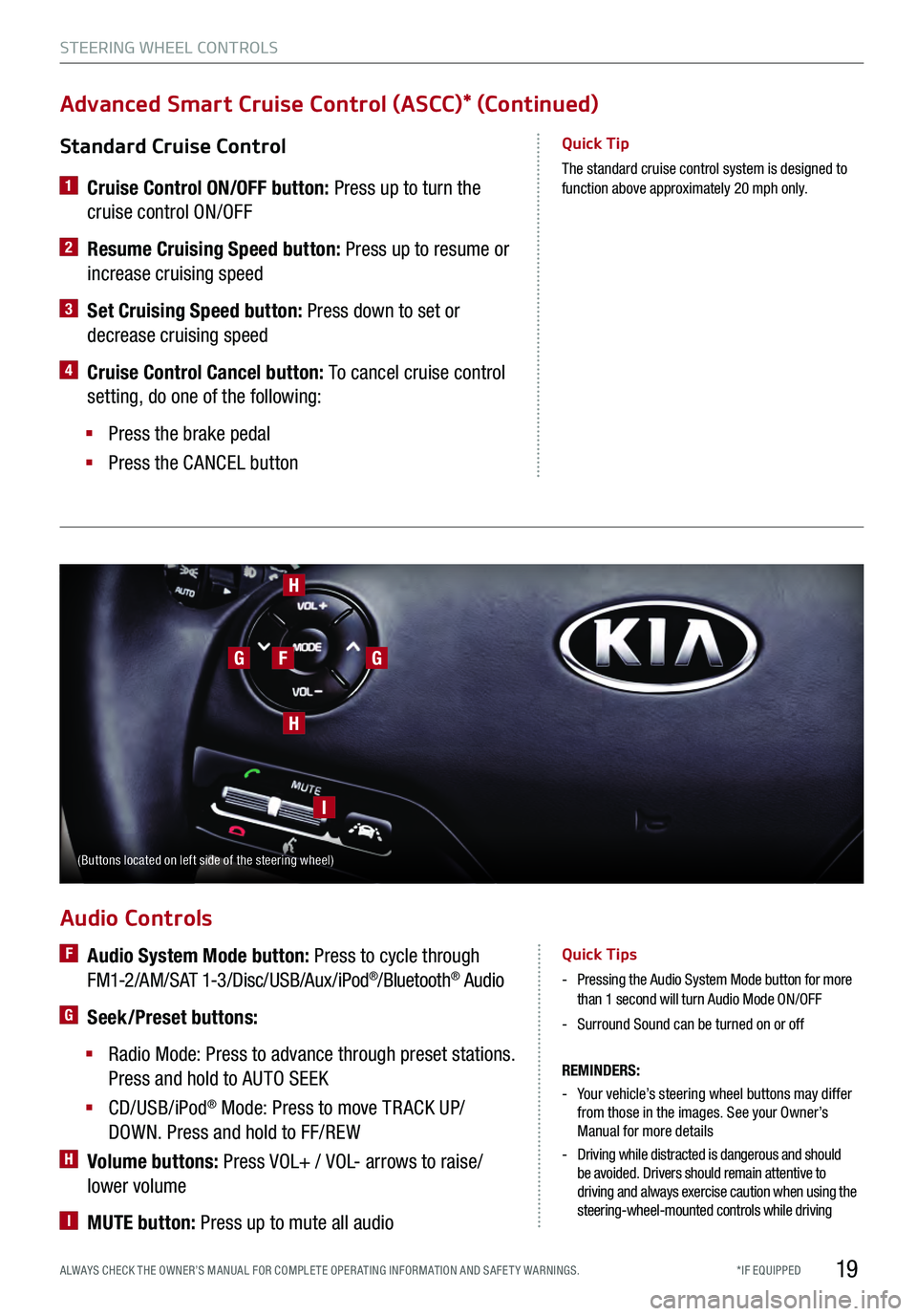
19
Standard Cruise Control
1 Cruise Control ON/OFF button: Press up to turn the
cruise control ON/OFF
2 Resume Cruising Speed button: Press up to resume or
increase cruising speed
3 Set Cruising Speed button: Press down to set or
decrease cruising speed
4 Cruise Control Cancel button: To cancel cruise control
setting, do one of the following:
§
Press the brake pedal
§
Press the CANCEL button
Quick Tip
The standard cruise control system is designed to function above approximately 20 mph only.
Advanced Smart Cruise Control (ASCC)* (Continued)
Audio Controls
REMINDERS:
- Your vehicle’s steering wheel buttons may differ from those in the images. See your Owner’s
Manual for more details
- Driving while distracted is dangerous and should be avoided. Drivers should remain attentive to
driving and always exercise caution when using the
steering-wheel-mounted controls while driving
F Audio System Mode button: Press to cycle through
FM1-2/AM/SAT 1-3/Disc/USB/Aux/iPod®/Bluetooth® Audio
G Seek/Preset buttons:
§
Radio Mode: Press to advance through preset stations.
Press and hold to AUTO SEEK
§
CD/USB/iPod® Mode: Press to move TR ACK UP/
DOWN. Press and hold to FF/REW
H Volume buttons: Press VOL+ / VOL- arrows to raise/
lower volume
I MUTE button: Press up to mute all audio
Quick Tips
- Pressing the Audio System Mode button for more than 1 second will turn Audio Mode ON/OFF
-Surround Sound can be turned on or off
H
G
H
I
GF
(Buttons located on left side of the steering wheel)
STEERING WHEEL CONTROLS
*IF EQUIPPED
ALWAYS CHECK THE OWNER’S MANUAL FOR COMPLE TE OPER ATING INFORMATION AND SAFE T Y WARNINGS.
Page 30 of 62

28
Automatic Transmission (Shift by Wire) and Sport Mode
To shift into any gear from Park, depress the brake pedal,
then press the Unlock button A, located on the side of the
gear shift lever, and shift.
P: Park – To shift into Park from any gear, press the P button
B on the gear shift while vehicle is stationary and the brake
pedal is depressed.
R: Reverse – To shift into Reverse, depress brake pedal,
press the Unlock button
A, and move the shift lever forward
twice to skip over Neutral and into Reverse.
N: Neutral
D: Drive
[+]: Sport Mode Upshift
[–]: Sport Mode Downshift
Sport Shift Mode: With the gear shift in Drive, pull the lever
to the left for Sport mode.
§ To upshift [+] – move the shift lever forward
§ To downshift [-] – pull the shift lever rearward
Paddle Shifters*: Paddle shifting is operable when the shift
lever is in the Sport mode position.
REMINDERS:
- Paddle shifters can be operated when the vehicle speed is more than 6 mph
- When in Sport mode, pulling the left and right paddle shifters at the same
time will NOT shift gears
www.KuTechVideos.com/kh13/2017
AUTOMATIC
TRANSMISSION
( SHIFT BY WIRE)
AND SPORT MODE
To view a video on
your mobile device,
snap this QR Code or
visit the listed website.
Refer to page 2 for
more information.
B
A
Quick Tips
- Press the Unlock button A when shifting from P
(Park) to any gear
- The instrument cluster and the light on top of
the shift lever identifies the gear the vehicle is
currently in
REMINDERS:
- When in P (Park), if the Unlock button is not pressed while shifting, the transmission does
not shift
- If the vehicle is turned off while in Neutral without shifting into Park, it will remain in Neutral until
the driver’s door is opened. At that point it will
automatically shift into Park
- If going through a car wash, remind the attendant to keep the vehicle in Neutral (N) and keep the
engine running. Also, disable the power trunk
lid control using the button inside the glove
compartment, turn off the auto rain-sensing
wipers and fold in the mirrors
(Button located on center panel below the gear shift)
CD
CENTER PANEL
*IF EQUIPPED
CENTER PANEL
*IF EQUIPPED
Page 31 of 62

29
The Electric Parking Brake (EPB) system utilizes an electric
motor to engage the parking brake.
Applying the Parking Brake
Depress the brake pedal and pull up the EPB switch
C.
Ensure that the indicator light
is illuminated on the
instrument cluster.
Releasing the Parking Brake
The EPB will automatically release when the shifter is placed
in Reverse or Drive. To release EPB manually, depress the
brake pedal, then press the EPB switch
C, with the ignition
switch in the ON position. Ensure that the indicator light
i s O F F.
Electric Parking Brake (EPB)
Auto Hold
Quick Tip
Pull up and hold EPB switch again to increase brake
pressure if parked on a decline or incline.
www.KuTechVideos.com/kh13/2017
ELECTRIC PARKING
BRAKE (EPB) / AUTO
HOLD VIDEO
To view a video on
your mobile device,
snap this QR Code or
visit the listed website.
Refer to page 2 for
more information.
REMINDERS:
- As a bulb check, the EPB malfunction indicator will illuminate for approximately 3 seconds when the ignition switch is turned ON
- If the warning light does not illuminate temporarily or remains continuously lit, take your vehicle to an authorized Kia dealer and
have the system checked
- The EPB should not be operated while the vehicle is moving
- A click or electric brake motor sound may be heard while operating or releasing the EPB. These conditions are normal and indicate
that the EPB is functioning properly
Auto Hold temporarily maintains the vehicle at a standstill even if the brake pedal is released. Auto
Hold can be turned On/Off using the AUTO HOLD switch D on the center panel. Before Auto Hold
will operate, the driver’s door, engine hood and trunk must be closed and the driver’s seat belt must
be fastened.
The Auto Hold indicator, which is in the instrument cluster, has four states:
White : Standby – With vehicle at a standstill, and AUTO HOLD switch
D turned ON, the indicator
will illuminate white. While driving the vehicle (vehicle is not at a standstill), the Auto Hold indicator
will remain white.
Green : Engaged – When coming to a complete stop by depressing the brake pedal, the Auto Hold
indicator changes from white to green.
OFF (not illuminated) – The indicator will turn OFF when the AUTO HOLD switch
D is manually
turned OFF or when the EPB is manually turned ON.
Yellow : Malfunction – When the indicator is illuminated yellow, there may be a system malfunction.
Take your vehicle to a local Kia dealer.
CENTER PANEL
*IF EQUIPPED
ALWAYS CHECK THE OWNER’S MANUAL FOR COMPLE TE OPER ATING INFORMATION AND SAFE T Y WARNINGS.
Page 52 of 62
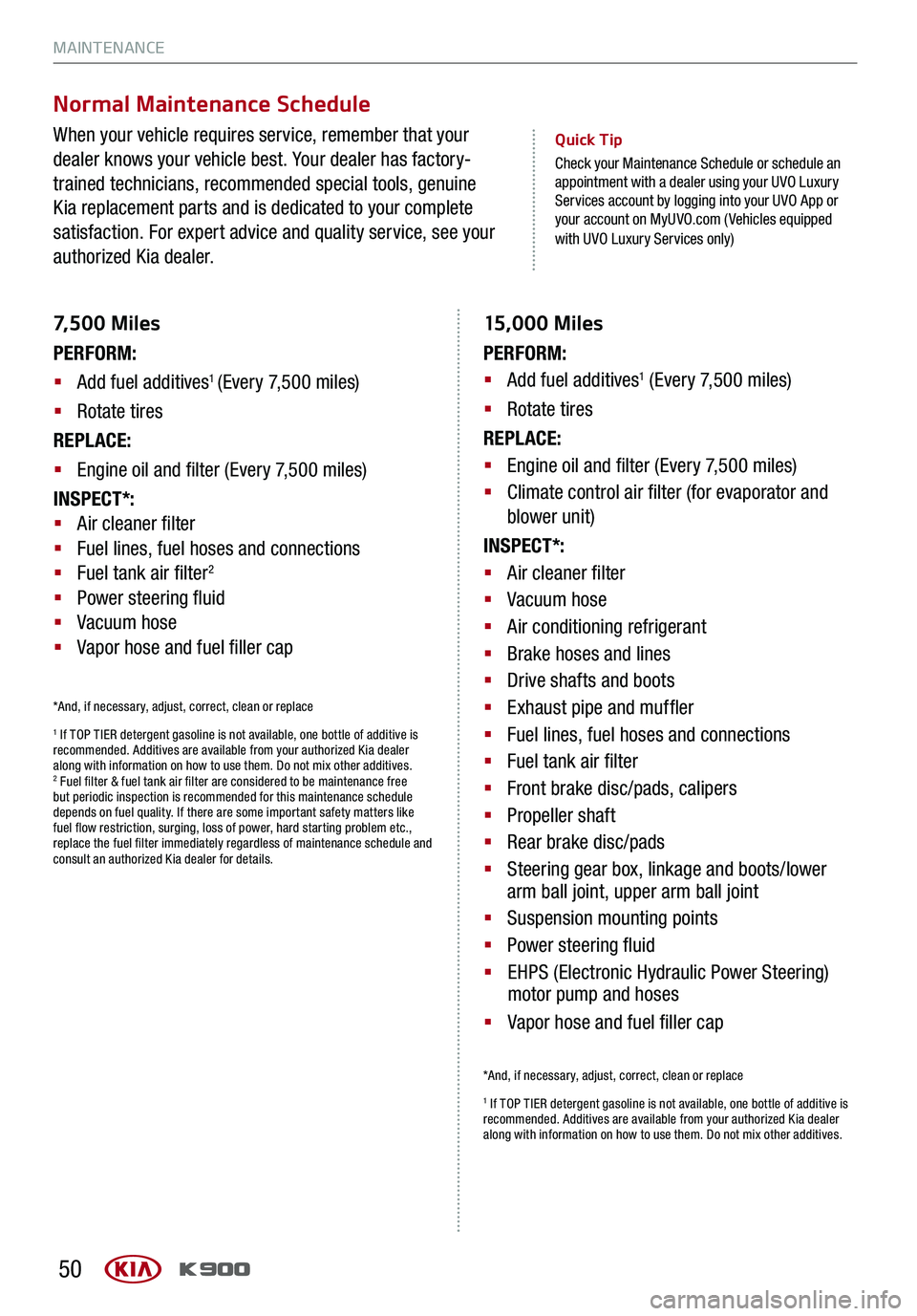
50
Normal Maintenance Schedule
When your vehicle requires service, remember that your
dealer knows your vehicle best. Your dealer has factory-
trained technicians, recommended special tools, genuine
Kia replacement parts and is dedicated to your complete
satisfaction. For expert advice and quality service, see your
authorized Kia dealer.
7, 5 0 0 M i l e s
PERFORM:
§
Add fuel additives1 (Every 7,500 miles)
§
Rotate tires
REPLACE:
§
Engine oil and filter (Every 7,500 miles)
INSPECT*:
§
Air cleaner filter
§
Fuel lines, fuel hoses and connections
§
Fuel tank air filter2
§ Power steering fluid
§
Vacuum hose
§
Vapor hose and fuel filler cap
15,000 Miles
PERFORM:
§
Add fuel additives1 (Every 7,500 miles)
§
Rotate tires
REPLACE:
§
Engine oil and filter (Every 7,500 miles)
§
Climate control air filter (for evaporator and
blower unit)
INSPECT*:
§
Air cleaner filter
§
Vacuum hose
§
Air conditioning refrigerant
§
Brake hoses and lines
§
Drive shafts and boots
§
Exhaust pipe and muffler
§
Fuel lines, fuel hoses and connections
§
Fuel tank air filter
§
Front brake disc/pads, calipers
§
Propeller shaft
§
Rear brake disc/pads
§
Steering gear box, linkage and boots/lower
arm ball joint, upper arm ball joint
§
Suspension mounting points
§
Power steering fluid
§
EHPS (Electronic Hydraulic Power Steering)
motor pump and hoses
§
Vapor hose and fuel filler cap
*And, if necessary, adjust, correct, clean or replace
1 If TOP TIER detergent gasoline is not available, one bottle of additive is
recommended. Additives are available from your authorized Kia dealer
along with information on how to use them. Do not mix other additives.
2 Fuel filter & fuel tank air filter are considered to be maintenance free
but periodic inspection is recommended for this maintenance schedule
depends on fuel quality. If there are some important safety matters like
fuel flow restriction, surging, loss of power, hard starting problem etc.,
replace the fuel filter immediately regardless of maintenance schedule and
consult an authorized Kia dealer for details.
*And, if necessary, adjust, correct, clean or replace
1 If TOP TIER detergent gasoline is not available, one bottle of additive is
recommended. Additives are available from your authorized Kia dealer
along with information on how to use them. Do not mix other additives.
Quick Tip
Check your Maintenance Schedule or schedule an
appointment with a dealer using your UVO Luxury
Services account by logging into your UVO App or
your account on MyUVO.com ( Vehicles equipped
with UVO Luxury Services only)
MAINTENANCE
MAINTENANCE